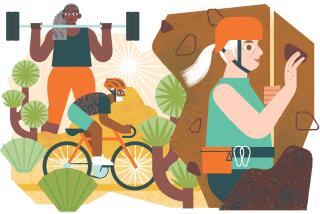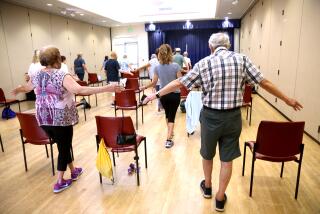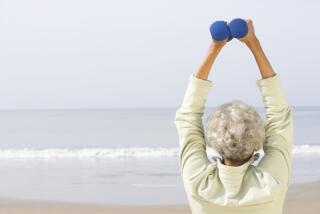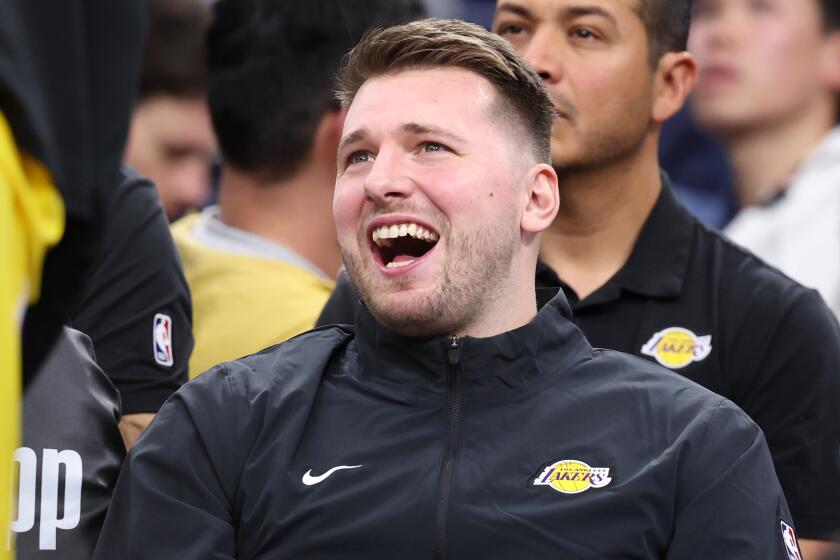When Your Body Takes On a Life of Its Own
- Share via
I spent my birthday astride a magnificent white horse on a trail ride through Griffith Park with my kids.
The next day, I had to struggle to climb a flight of stairs, and my legs and hips ached with every step.
Two days later--last Monday--I was flat on my back in bed, a hot water bottle pressed against ribs that throbbed with pain every time I took a breath.
And on Tuesday, I was on an X-ray table at Good Samaritan Hospital, waiting to find out if I had, indeed, fractured a rib as I had struggled to control Big Tex and corral the horses carrying my three little girls.
Maybe Tex was a bit more rambunctious than the horses I was accustomed to riding. And, yes, it had been years since I’d done anything more ambitious on horseback than amble along a scenic trail.
Still, I’d felt like Dale Evans in the saddle that day, and it never occurred to me that the afternoon’s equestrian antics might be more vigorous than my aging body could take.
Turns out it was no broken rib, just a case of costochondritis--something involving inflammation, injured tendons and ligaments and at least a week’s worth of excruciating pain.
My doctor says it can occur when a sudden burst of activity puts too much stress on aging muscles, tendons and joints. He sees it often in middle-aged and elderly patients, he says.
Ouch! What a blow to my pride . . . and a humbling birthday surprise.
After all that talk about being young at heart, it hurts to realize that while my spirit may be a spunky ingenue, my body is, alas, 43 years old. And feeling it.
*
There’s a medical term for what’s happening to me, and to us all: homeostenosis--the declining ability of the aging body to adapt to physical stresses and demands.
No matter how often we work out or how young we look, the process of aging inevitably robs the body of some of its resilience, diminishing its recuperative powers.
Those 90-year-olds we hear about running marathons or climbing mountains? Freaks of nature, says Dr. David Reuben, chief of geriatrics at UCLA Medical Center.
Although, “taking care of yourself, exercising, paying attention to your weight and diet can help you maintain good health as long as possible . . . as you get older, your body becomes less adaptive, less forgiving,” he says.
The classic case, he tells me, is the middle-aged guy who goes out with his kids one weekend to shoot baskets or play touch football and winds up limping for weeks afterward with a muscle strain.
Or, I think to myself, the middle-aged woman who gets up on a big horse for the first time in years and winds up bedridden. I wince involuntarily and grab my rib.
And it’s not just the sedentary who are so afflicted.
At 45, Reuben is an avid exerciser. Still, he feels homeostenosis taking its toll.
“I’ve been swimming for 20 years, and every year my times get a little slower,” he says. “I swim the same amount, under the same conditions, but every year the same lap goes about 2 seconds longer.”
If only declining athletic performance were the worst of it.
“Your reaction time slows, your memory gets fuzzy, your body doesn’t heal as quickly--whether it’s from a cut or the common cold,” says Dr. Andrew Leuchter, director of adult psychiatry at UCLA.
“You start noticing in your 40s that you can’t do all the things you used to do. For some people that’s traumatic. . . . It gives you a sense of losing control over your body as you age.
“I’m 43 and I feel it happening. And I don’t like it,” he says.
*
But we baby boomers are not going quietly into that good night.
Instead, the burgeoning “anti-aging industry” is becoming big business, Reuben says, “with lots of money being thrown around and enormous interest” in whether herbs, hormones or homeopathy can halt the progressing infirmities of age.
The new American Academy of Anti-Aging Medicine has 3,100 members and convenes each year in Las Vegas, hosting everyone from research scientists studying the cellular processes involved in aging to charlatans peddling purported fountains of youth.
But until they find a way to turn back the clock, “adaptability and flexibility” are the keys to living peacefully--without hospitalization--with the limitations of advancing age, Leuchter says.
You might have to adapt by giving up, like my friend Ray, who hung up his cowboy hat and swore off line dancing two years ago when a bad back made his high-heeled boots too painful and dangerous to wear.
Others, Leuchter says, continue the sporting life by making accommodations. “Maybe you accept that you can’t ski as aggressively as you used to, because your reaction time is not as good and if you fall it’s going to hurt you more. So you stick to an easier slope or you ski only in good weather.”
And others nurse their wounds and count the days until they’re back in the saddle. Rest up, Big Tex. I’m coming back.
*
* Sandy Banks’ column is published Mondays and Fridays. Her e-mail address is [email protected].
More to Read
Go beyond the scoreboard
Get the latest on L.A.'s teams in the daily Sports Report newsletter.
You may occasionally receive promotional content from the Los Angeles Times.










